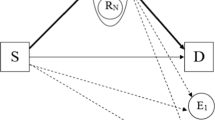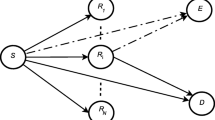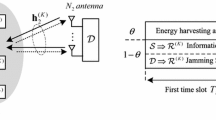Abstract
The impact of unavailable relays is a serious issue in cooperative communication schemes, where the operation state of relays affects optimal relay selection. In addition, secure signal transmission is an interesting approach to prevent the wiretapping actions of eavesdropper nodes in a wireless environment. In this paper, we propose two cooperative secrecy transmission schemes: a secrecy decode-and-forward protocol and a hybrid of direct secrecy and cooperative secrecy transmission schemes to enhance the spectrum utilization efficiency. In the proposed schemes, a source transmits data signals to a destination with the assistance of relays. At the same time, these data signals are eavesdropped by another node. The best relays are successfully selected in a safe manner based on both decoding from a source to a destination and the available state of cooperative relays. The secrecy performance of each scheme is analyzed and evaluated by the exact outage probability over Rayleigh fading channels. Monte Carlo simulations were performed to verify the theoretical analysis. Finally, a discussion and comparison of the cooperative secrecy transmission schemes and the direct secrecy transmission approach are presented.





Similar content being viewed by others
References
Nosratinia, A., Hunter, T. E., & Hedayat, A. (2004). Cooperative Communication in Wireless Networks. IEEE Communications Magazine, 42, 74–80.
Laneman, J. N., Tse, D. N. C., & Wornell, Gregory W. (2004). Cooperative diversity in wireless networks: Efficient protocols and outage behavior. IEEE Transactions on Information Theory, 50, 3062–3080.
Xia, M, & Aissa, S. (2012). Cooperative AF relaying in spectrum-sharing systems: Outage probability analysis under co-channel interferences and relay selection. IEEE Transactions on Communications, 60, 3252–3262.
Ikki, S. S., & Ahmed, M. H. (2010). Performance analysis of adaptive decode-and-forward cooperative diversity networks with best-relay selection. IEEE Transaction on Communications, 58, 68–72.
Tourki, K., Yang, H-C, & Alouini, M.-S. (2011). Accurate outage analysis of incremental decode-and-forward opportunistic relaying. IEEE Transactions on Wireless Communications, 10, 1021–1025.
Salhab, A. M., Al-Qahtani, F., Zummo, S. A., & Alnuweiri, H. (2013). Outage analysis of Nth-best DF relay systems in the presence of CCI over Rayleigh fading channels. IEEE Communications Letters, 17, 697–700.
Duy, T. T., & Kong, H.-Y. (2013). Performance analysis of incremental amplify-and-forward relaying protocols with Nth best partial relay selection under interference constraint. Wireless Personal Communications, 71, 2741–2757.
Wyner, A. D. (1975). The wire-tap channel. Bell System Technical Journal, 54, 1355–1367.
Dong, L, Han, Z, Petropulu, A. P., & Poor, H. V. (2010). Improving wireless physical layer security via cooperating relays. IEEE Transactions on Signal Processing, 58, 1875–1888.
Wang, H-M, Yin, Q, & Xia, X-G. (2012). Distributed beamforming for physical-layer security of two-way relay networks. IEEE Transactions on Signal Processing, 60, 3532–3545.
Kim, J, Ikhlef, A., & Schober, R. (2012). Combined relay selection and cooperative beamforming for physical layer security. Journal of Communications and Networks, 14, 364–373.
Stanojev, I., & Yener, A. (2013). Improving secrecy rate via spectrum leasing for friendly jamming. IEEE Transactions on Wireless Communications, 12, 134–145.
Liang, Y, Poor, H. V., & Shamai, S. (2008). Secure communication over fading channels. IEEE Transactions on Information Theory, 54, 2470–2492.
Son, P. N., & Kong, H. Y. (2013). Exact outage probability of decode-and-forward scheme with best relay selection under Physical Layer Security. Wireless Personal Communications, 74, 325–342.
Pei, L., Zhifeng, T., Zinan, L., Erkip, E., & Panwar, S. (2006). Cooperative wireless communications: A cross-layer approach. IEEE on Wireless Communications, 13, 84–92.
Yang, H-C, & Alouini, M-S. (2011). Order statistics in wireless communication: Diversity, adaptation, and scheduling in MIMO and OFDM systems. Cambridge: Cambridge University Press.
Chong, E. K. P., & Zak, S. H. (2001). An introduction to optimization (2nd ed.). Hoboken: Wiley.
Author information
Authors and Affiliations
Corresponding author
Rights and permissions
About this article
Cite this article
Son, P.N., Kong, H.Y. Exact Outage Probability of Cooperative Secrecy Transmission: Impact of Unavailable Relays. Wireless Pers Commun 85, 727–740 (2015). https://doi.org/10.1007/s11277-015-2805-4
Published:
Issue Date:
DOI: https://doi.org/10.1007/s11277-015-2805-4




